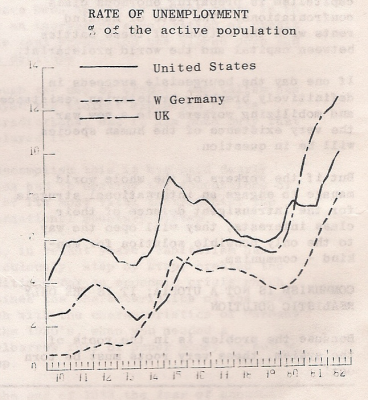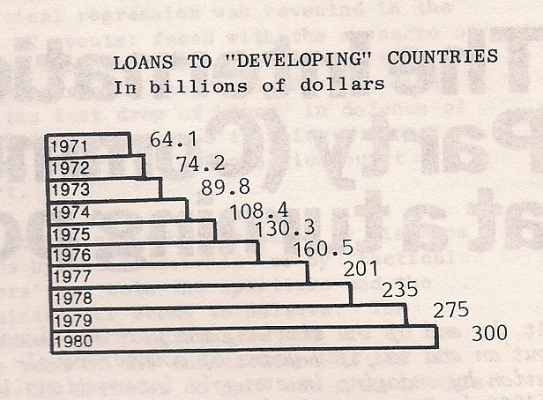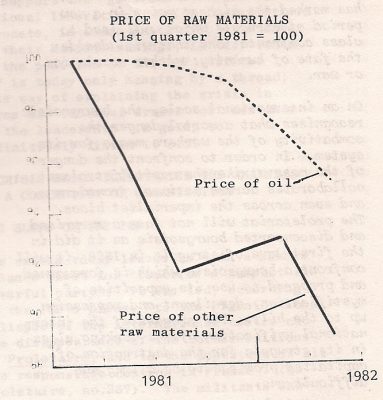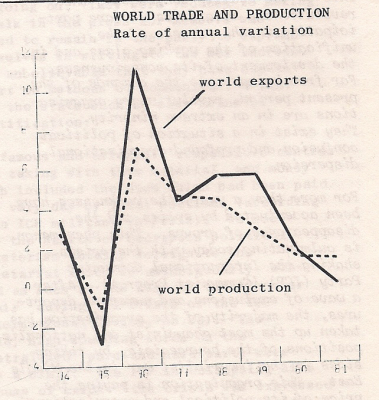Submitted by International Review on
Mankind has developed productive forces which if put to good use could in several years time eliminate on this planet all scarcity in food supplies, housing, health services and communication. But today, these forces, this enormous productive potential, is increasingly paralyzed and destroyed by the mechanisms and internal contradictions of the capitalist mode of production.
More and more the world is being deprived of everything as it plunges into a capitalist crisis of overproduction.
By the end of 1982, unemployment figures in the major industrialized countries had broken all records since World War 2. Moreover, the rate of unemployment is still steadily increasing: a half a million more unemployed in the US in a single month.
The same record-breaking phenomenon and the same accelerating rhythm applies to business failures and countries sliding into financial bankruptcy. Famine is spreading in the underdeveloped zones of the world.
In the Eastern bloc food rationing rivals the worst years of the Second World War. And in the heartland of the most powerful country in the world, in Detroit, unemployed workers at the end of their funds line up in front of soup kitchens.
At the same time, factories are closing down or working at a steadily decreasing percentage of their capacity (70% in the US; the European steel industry is paralyzed at 50%!). Agricultural surplus is being destroyed and prices of agricultural and industrial raw materials are plummeting because there are no buyers.
In terms of future perspectives, governments have now abandoned the rhetoric of “the light at the end of the tunnel” and are now talking about “preparing for years of sacrifice and austerity”.
The reality of the crisis is more and more obvious. ‘Natural’ causes (lack of energy sources or raw materials) are not responsible for blocking the productive machinery: international traders do not know what to do with all the unsold stocks of oil and milk. It is not the lack of manpower either (educated or not): unemployment is hitting illiterate workers, workers with diplomas or without, and university graduates.
It is not a lack of technological innovation: the most advanced sectors of modern industry (electronics, computers) which were spared in the early days of the crisis are being hit now. Silicon Valley in California, the world mecca for advanced electronics, is for the first time hit by unemployment. It is not for any lack of ‘good capitalist economic policies’ either; all economic policies are failing. Reagan’s policy promising recovery through spending cuts and a balanced budget has brought neither recovery nor a balanced budget. Production has fallen in the US and the State deficit is at one of the highest points in the history of the country. Mitterand’s policy which, on the other hand, promised recovery through a rise in consumption and an increase in the State deficit has indeed inflated the deficit but industrial production has continued to decline like the workers’ standard of living. Eastern bloc state capitalism is suffocating in the swollen growth of arms production.
With each convulsion of the crisis, one thing comes clearer: the source of the paralysis of the productive forces is to be found in the world social system of production itself.
Once again in less than 50 years, mankind is living through a merciless demonstration that capitalist laws of production are historically played out.
Whether they want to or not, the exploited classes are going to have to face the issues that this bleak and frightening perspective raises.
Can there be a new period of relative ‘economic recovery’ once again as there was after the convulsions of 1967, 1970 or 1974-5? Is a genuinely communist solution to the crisis simply a utopian dream?
Can there be a short or medium-term economic recovery?
First let us see what the experts of western international economic organizations have to say. The Financial Times of November 17, 1982 reported the conclusions of the OECD’s Committee on Economic Policy concerning predictions for 1983:
“The secretariat of the organization now doubts that the prediction it made for a 2.5% increase in production in 1983 can be achieved, because of the stagnation in 1982. No growth is to be expected in Europe next year and the Japanese economy will continue its slow-down, partly caused by the agreements on export limitations. The OECD is less optimistic than Washington concerning any solid economic recovery in the US”.
Those who in principle are responsible for the functioning of the capitalist economy see no possibility for recovery in the near future. At most, some of them predict a momentary slow-down in the economic decline of the US and only in the US, just in time for the presidential elections... But judging by the present evolution of the situation even this paltry perspective seems unrealistic.
Some ‘savants’ of the decadent bourgeoisie talk about an eventual economic recovery in the ‘long-term’ but they do not know where or when or how such a recovery could happen.
This lack of any future perspective expresses the impasse of the bourgeoisie; it is forced to deal not only with the growing ineffectiveness of all its economic policies but with the accumulation of difficulties these policies have themselves produced.
As we wrote at the beginning of 1980:
“Not only have the remedies that the governments used to fight the crisis proven increasingly ineffective but the abusive use of these remedies has led to a poisoning of the patient”. (International Review no. 20, ‘The 80s: The Acceleration of the Crisis’).
The financial insolvency of the governments of Mexico, Argentina, Poland, and Zaire is not a problem ‘localized’ in the less-industrialized regions. It sanctions the failure of international capitalist policies founded on generalized deficit-spending, debts and credit.
The media talk a lot about the debts of the less-developed countries. But the estimated 500 billion dollars debt of these countries seems laughable when compared to the debts of the most powerful countries...especially the US. In this strongest industrial metropole of the world, the general economic debt from 1960--1980 multiplied by 5.4! From 1970 to 1980 the American public sector debt went from. 450 billion dollars to 1069 billion dollars; the private sector debt went from 975 billion dollars to 2840 billion dollars!
Today, more and more debts are coming due but the debtors do not have any real means of paying, no more than they had when they first began this policy of massive credits. In this situation no government cares to talk about a genuine recovery.
The Achilles heel, the congenital handicap of capitalism, is that it cannot itself create markets enough to absorb, to buy, all the potential production it is capable of bringing forth. Unlike slave societies of ancient history or feudalism when capitalism becomes historically unable to assume society’s material means of survival, it is not because of any lack in the means of production (capitalism has “too much” in a overproduction crisis) but because there are not enough paying markets.
Decadent capitalism, whose scarcity of markets has led to two world wars, whose subjection of all social life including the most advanced scientific research to the military imperative of “protecting markets” from each other; this sterile and barbarous system thought that credit could be a palliative for the chronic lack of solvent markets, especially since the end of the sixties -- in other words, since the end of the post-war reconstruction.
But the development of credit can only ease the functioning of the economy if it is accompanied from time to time by a corresponding increase in the capacity for real payment of those who have become debtors. Otherwise it merely masks the fundamental problem, delays the payment question and worsens the situation. What we have been seeing in recent years is in fact an increasing acceleration of credit while real production has slowed down and even declined.
Through the use of credit, capitalism has delayed the violent explosion of its contradictions, but it has done only that -- delayed it.
To accomplish this it has paid dearly. It has had to destroy the foundations of one of its most vital instruments, the international monetary system.
Thus, in recent years, capitalism has meticulously, step by step, created the conditions for an economic crisis which combines the characteristics of the 1929 crash with the characteristics of Germany in 1920s, when you needed a wheelbarrow full of paper money to buy a stamp.
At the end of 1982 the fear of economic collapse due to the growing number of insolvent debtors led to a wave of panic in the financial world. What is the solution they have come up with?
To stampede ahead with more of the same thing: increasing the amount of money in circulation through the International Monetary Fund, the Special Drawing Rights (reportedly 50% more!).
To prevent a financial crash, which would mark capitalism’s inability to counterbalance the lack of solvent markets through credit, through an excess of paper money, capitalism has no other solution but to produce...more paper.
For the capitalists, the problem is less and less “how to bring about a recovery” and more and more “how to avoid an uncontrollable collapse”.
This spells the end of illusion for those who believed in the purely “monetary” nature of the crisis or in the explanation of “restructuration”. The real cause of the crisis is at the heart of production relations, in the way the different classes of society work together to produce.
For the workers, capitalism has only one perspective to offer, unemployment, misery, exclusion from society. Less and less able to rule through the strength of the economy, capital rules and will rule more and more through force and terror. It is the language of “austerity”, of unemployment blackmail, of forced sacrifices.
But misery and poverty open no doors to economic recovery; on the contrary, they just further shrink the existing markets. And yet each national capital is forced by international competition to take this road.
Slowly but inexorably the collapse of capitalism is preparing enormous class confrontations. The fate of mankind rests with the outcome of these battles between capital and the world proletariat.
If one day the bourgeoisie succeeds in definitively breaking proletarian resistance and mobilizing workers into a new war, the very existence of the human species will be in question.
But if the workers of the whole world manage to engage an international struggle for the intransigent defense of their class interests, they will open the way to the only possible solution for mankind -- communism.
Communism is not a utopia; it is the only realistic solution
Because the problem is in the roots of the system, these very roots must be torn out!
Capitalist institutions, capital itself, wage-labor, the market, commodities, nations, have all become living absurdities in terms of the needs and capacities of humanity.
The basis of the laws of capitalism dates back to the end of the Middle Ages. At that time a serf with his work and the work of his whole family could scarcely feed a single member of the nobility. Today an agricultural worker in the US can feed 80 people. But just like the workers of the Renaissance, his income is not determined by his needs, or by the productive possibilities of the society as a whole but by the value of his labor power as a commodity on the market. Just as in the time of the merchants of Venice, capital produces and will always produce only as a function of the needs of its own accumulation.
When for reasons of the market this accumulation becomes impossible, capitalist production collapses, whatever the productive forces society has at its disposal, whatever the needs of mankind.
Humanity will not be able to avoid a violent, world social revolution, completely changing the organization of society from top to bottom.
Factories must be made to function only for the fulfillment of human needs; production must be distributed according to the needs and possibilities of man, and the market and wage labor must be eliminated. Mankind will have to consciously unify world production -- in a word, create socialism.
The crisis which is only at its beginnings today will by its devastation show that what seems to be a utopian dream right now is in fact the only possible way to escape from nuclear holocaust.
Each day more the economic crisis will place the burden of historical responsibility on the shoulders of the world proletariat: either break the chains of the old world or perish with it.
What point has the crisis reached?
Industrial production is at the level of 1973
For the fourth time since the beginning of the crisis at the end of the 60’s, capital is experiencing a fall in industrial growth which following the past pattern will be more profound than each previous fall.
Since 1978 industrial production has declined overall in the major western countries.
At the end of 1982, production fell to the 1973 level in most of these countries: that means to the level of 10 years ago.
Japan is now in its turn feeling the crisis: growth has continually slowed down and the fall will be all the more brutal as in 1974-5.

Unemployment accelerates
The number of unemployed and the proportions of unemployed in the active population are at the highest level since the war.
But the rate of unemployment far from slowing down has been speeding up since 1980 at an unprecedented pace.
“The bourgeoisie is unfit to rule because it is incompetent to assure an existence to its slave within his slavery, because it cannot help letting him sink into such a state, that it has to feed him instead of being fed by him. Society can no longer live under this bourgeoisie, in other words, its existence is no longer compatible with society”. (Marx and Engels, The Manifesto of the Communist Party).

The crisis is ahead of us
The unemployment rate is still far from the level of the depression in the 30’s. This should not be a “consolation” but an illustration of how far capitalism can go in this crisis if the international proletariat does not have the strength to impose its revolutionary solution.

The explosion of debts
The “solution” adopted, opening the flood gates of credit, is clearly seen in the evolution of the debt of less developed countries (it has increased fivefold in10 years).
But this is only a small part of the global debt of world capitalism.

The fall in raw materials
The crisis of overproduction is shown by a fall in demand and in the prices of raw materials especially since 1981.
For the less developed countries which are generally producers of raw materials, this means certain bankruptcy.
The fall in oil prices at a time when the crisis is deepening has destroyed the myth of the ‘oil crisis’.

The slowdown of world trade
The growth of world trade, like production, has constantly slowed down since 1977.
In 1982 the growth of international trade fell in absolute terms and faster than the volume of production. This has led to the development of protectionism.

Sources: Annual Report of the GATT 1981/2; Newsweek; OECD "Principaux Indicateurs Economiques".






 del.icio.us
del.icio.us Digg
Digg Newskicks
Newskicks Ping This!
Ping This! Favorite on Technorati
Favorite on Technorati Blinklist
Blinklist Furl
Furl Mister Wong
Mister Wong Mixx
Mixx Newsvine
Newsvine StumbleUpon
StumbleUpon Viadeo
Viadeo Icerocket
Icerocket Yahoo
Yahoo identi.ca
identi.ca Google+
Google+ Reddit
Reddit SlashDot
SlashDot Twitter
Twitter Box
Box Diigo
Diigo Facebook
Facebook Google
Google LinkedIn
LinkedIn MySpace
MySpace